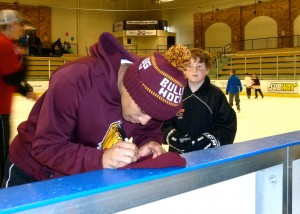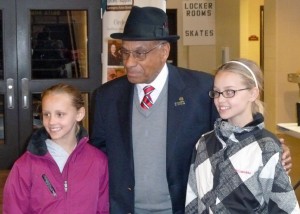Cup play is distant, Willie O’Ree comes up close
John Gilbert
When you think about it, this has been the year of the upset throughout hockey. Just think back to the state hockey tournament, when the coaches and league officials got together and seeded the top four teams, then drew their opponents — sure enough, the top four seeds all were upset by the other guys.
Pretty much under the general public radar, the Women’s World Tournament came just after the NCAAs and the Stanley Cup Playoffs, and was held in Burlington, Vermont. The women remain locked in a U.S. vs Canada mode, because those teams continue to meet in every gold medal game of every tournament, and as they continue to strive to improve at the top, they seem oblivious to the fact that their future may only depend on the other nation’s improving to make it more than a two-team race.
This time, when the first round got going, the U.S. shocked Canada 9-2. It was the most lopsided loss anyone can remember in Canadian women’s hockey history. At that point, I said to my family, “Payback can be hell.”
Both the U.S. and Canada kept winning after that, and, sure enough, they met in the final for the umpteenth time — all but one, actually, when Sweden, behind future UMD goaltender Kim Martin, upset the U.S. in the semifinals before losing to Canada in the final. The gold medal game was no 9-2 romp, and if you remember Caroline Ouellette, one of the greatest UMD stars ever, you won’t be surprised that she scored the overtime winner to lift Canada to a 5-4 triumph. Ouellette’s goal was her second of the game; her first staked Canada to a 3-1 lead before the U.S. rallied to go ahead 4-3 when former Badger Brianna Decker scored a goal and former Gopher Gigi Marvin scored two goals. Ouellette assisted on Megan Agosta’s tying goal with 2:38 left, but in overtime, Canada got the only three shots in the 2:57 of action that was ended by Ouellette’s second goal.
You could go to the USA Hockey website and look it up, but if you do, don’t be surprised when the gold medal game story features the fact that the U.S. won the silver medal, and names all the U.S. scorers, but snubs Canada by never naming a single Canadian goal scorer or player, even though all the Canadian players were former U.S. college standouts. Is it arrogance or just a lack of class, to say nothing of sportsmanship, that prevents USA Hockey from respecting their opponents enough to broaden the world of women’s hockey, rather than trying to make it appear there is only one team participating?
Fast forward to what I call the most evenly matched NHL Stanley Cup Playoffs in my lifetime. Every single first-round match was a virtual toss-up, and they have played out that way.
In the East, where the last three first-round matches were the last to be completed, No. 8 Ottawa had taken No. 1 New York Rangers to a deciding seventh game, and No. 7 Washington was in position to finish off No. 2 Boston in the seventh game. New Jersey and Florida were also still battling, but that was one that we knew would be close also. The first East series to end was when Philadelphia — my pick to win the East — hustled the amazingly chippy and distracted Pittsburgh Penguins in five games. Sidney Crosby and Evgeni Malkin being healthy made the Penguins the choice of many to win the Cup, but Claude Giroux outplayed both of them.
In the West, the No. 8 Los Angeles Kings snuffed the No. 1 overall seed Vancouver Canucks in five games with great hustle, teamwork, and the goaltending of Jonathan Quick. Two old-guard favorites, the Detroit Red Wings and the Chicago Blackhawks, also fell victim to the NHL’s emerging new breed, as Phoenix knocked out Chicago and Nashville thumped the Red Wings, both in six-game match-ups.
But St. Louis was the most impressive of all the Western teams, and they remain my pick to win the incredibly balanced West. The Blues beat a very strong San Jose outfit in five games, behind former Badger Brian Elliott’s superb goaltending and an offense ignited by Minnesota natives T.J. Oshie and David Backes. If the Blues are going to win the West and reach the Cup final, they next will have to overcome the Kings, who are playing the best hockey in the franchise history. Should be a great second-round match-up, because neither one got entangled in the vicious, suspension-laden garbage of some other first-round tangles. If you like goaltending, Elliott against Quick will be a treat to watch.
ECONOMIC DISCRIMINATION
J.T. Brown had two sensational seasons for UMD, being named most valuable player of the Bulldogs NCAA title run as a freshman, and helping the Bulldogs reach the Northeast Region final before losing to eventual champion Boston College. Brown left college to sign an NHL contract with Tampa Bay as a prize free agent, and even got into a few games at the end of the season.

Always a Bulldog: J.T Brown, who signed with Tampa Bay after the season, signed autographs at Heritage Center.
Brown came back to Duluth last week, and before leaving to prepare to play for the U.S. in the men’s World Championships in Sweden and Finland, he spent Friday and Saturday at Heritage Center, signing autographs and skating with area youngsters as part of the “Pucks Against Poverty” fund-raising weekend to aid kids from families that might be unable to afford to get started playing hockey.
One of Brown’s main objectives was to meet and talk to Willie O’Ree, who appeared both days as the primary attraction for the fund-raiser. O’Ree, 76, was the first black man to play in the National Hockey League, playing briefly in parts of two seasons in the late 1950s. J.T. Brown said he can only imagine what O’Ree went through to make the trail far easier for black players, such as Brown, to go into the NHL in the 21st Century. Brown made his break at home, where he dad, former Vikings running back Ted Brown, caused everyone to figure J.T. would play football.
“I played football through ninth grade, and it was fun, but I didn’t like it as much as hockey,” said J.T. “My dad wasn’t really into hockey, but he enjoys it a lot now.
“It’s great to be able to come out here with all the kids, and to meet Willie. Obviously, he’s done so much for hockey.”
O’Ree, always personable, was a big hit with all the families and kids who came to the event at Heritage. He said he has worked for the NHL for 14 years as director of its diversity program, which raises money to make it easier for kids to get into hockey and overcome the huge obstacle of expensive equipment.
He said he never experienced any racial discrimination growing up in Fredricton, New Brunswick, a town just north of the border with Maine, although he had a jolt when he first was drafted by the Milwaukee Braves of the National League, just before the franchise moved to Atlanta.

Willie O'Ree posed for endless souvenir photos as the prime attraction at the Pucks Against Poverty fund-raiser.
“After I got drafted, they brought me down to their training camp in Georgia,” O’Ree recalled. “The first thing I saw in Atlanta were rest rooms marked ‘white,’ and ‘colored.’ They took us by bus to Waycross, Ga., for spring training, and we had to ride in the back of the bus. They put us in a dorm with seven other ‘players of color.’ It was the same at drinking fountains, where we couldn’t drink from the ‘white’ fountains. I played shortstop and second base, and I didn’t make it, but after two weeks of experiencing what segregation was like down there, I was happy to be cut.”
Back home, O’Ree pursued his other love, hockey. He played junior in Quebec City and then Kitchener, Ontario. After his chance with the Bruins, O’Ree played mostly in the Western League, and he still lives in San Diego.
Willie said he was impressed to meet J.T. Brown, and wished him well as he starts on his NHL career. I suggested to Willie that there really is no racial discrimination in hockey these days — the real discrimination is money. Willie thought I meant the huge salaries players get nowadays, but I meant going back down to the grassroots level. Hockey equipment is so expensive that many kids from families struggling more than ever in the current economy can’t afford skates, that can run well over $100 or $200 or $300, and all the other necessary equipment is costly as well.
In the Twin Cities, part of John Mariucci’s legacy is an inner-city program to help kids get equipment enough to start playing. O’Ree said he’s aware of that, and has visited the Twin Cities as he expands his effort to get the NHL more involved in similar funding.
“It’s important to make the game affordable for kids,” said O’Ree. “We used to have four programs, and now we’re up to 34, mostly in NHL cities. We’ve opened up opportunities for a lot of kids who never had the opportunity to play.”
O’Ree met with Clark Coole, the longtime director of the Duluth Amateur Hockey Association, who arranged for O’Ree to talk to other hockey officials in the Duluth area.
“They might be able to help get us some funding to help out kids in low-income families,” Coole said. “If we can get equipment for those kids, we know they’ll love the game. We have a plan in place now for street-hockey equipment, and kids can play boot hockey in the second Heritage Center rink area in the summertime.”
It was an honor to meet a true hockey pioneer in Willie O’Ree, and it’s gratifying to see that he is still trying to break down barriers to help kids get acquainted with hockey.
Comments
One Comment on Cup play is distant, Willie O’Ree comes up close
-
Nike Free 3.0 V6 Black Red Is In Big Discount Now on
Thu, 19th Mar 2015 10:46 pm
With havin so much content do you ever run into any issues of plagorism or copyright violation? My blog has a lot of exclusive content I’ve either authored myself or outsourced but it seems a lot of it is popping it up all over the internet without my authorization. Do you know any ways to help prevent content from being stolen? I’d definitely appreciate it.
(Plagiorism is always a problem, even when spelled correctly…JG.)
Tell me what you're thinking...
and oh, if you want a pic to show with your comment, go get a gravatar!


 John Gilbert is a lifetime Minnesotan and career journalist, specializing in cars and sports during and since spending 30 years at the Minneapolis Tribune, now the Star Tribune. More recently, he has continued translating the high-tech world of autos and sharing his passionate insights as a freelance writer/photographer/broadcaster. A member of the prestigious North American Car and Truck of the Year jury since 1993. John can be heard Monday-Friday from 9-11am on 610 KDAL(www.kdal610.com) on the "John Gilbert Show," and writes a column in the Duluth Reader.
John Gilbert is a lifetime Minnesotan and career journalist, specializing in cars and sports during and since spending 30 years at the Minneapolis Tribune, now the Star Tribune. More recently, he has continued translating the high-tech world of autos and sharing his passionate insights as a freelance writer/photographer/broadcaster. A member of the prestigious North American Car and Truck of the Year jury since 1993. John can be heard Monday-Friday from 9-11am on 610 KDAL(www.kdal610.com) on the "John Gilbert Show," and writes a column in the Duluth Reader.